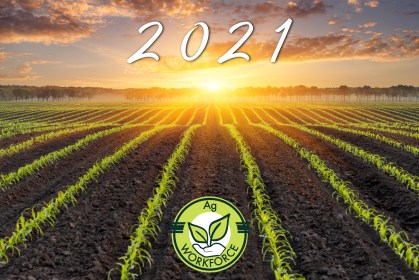
With spring just around the corner and 2020 now behind us, producers and agribusinesses alike anticipate what is to be expected of 2021. The industry suffered the effects of the Covid-19 pandemic as the world reacted, quickly shutting down schools and restaurants to slow the spread of the virus. As we start to see the healing process begin with the introduction of a vaccine, we hope that life will start returning to normal and our farmers will yield greater profits than that of 2020, however, even more uncertainty is expected.
In response to the crisis, the government instituted the Coronavirus Food Assistance Program (CFAP) and other stimulus packages to aid farmers through these unprecedented times. It is estimated that although the 2020 Net Farm Income was up 43.1% from 2019, over 40% can be attributed to the government assistance. It is expected that producers shouldn’t count on more federal aid to subsidize their incomes during 2021. It is imperative to understand what is going on within the industry, and how it will affect the production and distribution of our food. The price of goods is not only a direct indicator of the balance within the food supply chain, but influences the income of farmers and producers.
There are many factors that will impact the agricultural trends of 2021. China is currently yielding smaller than expected crops due to heavy winds and rains, increasing U.S. exports of grains, corn and livestock. Corn exports have reached 189 million bushels in total sales in just the first four weeks of January and are only anticipated to grow, doubling that of January 2020. This is the case across the grains market, especially soybeans, which is projected to tie for the second highest yield on record just to reach the demand of China’s needs. These crop yields also are affected by other lead grain exports such as Argentina and Brazil. However, this demand has increased the price of products in the grain market, making the grains that feed our livestock more costly to farmers.
The dairy industry was similarly turned upside down from the shockwaves of the pandemic. Schools and restaurants closed their doors and have, only recently, slowly been reopening. These are two major markets for the dairy industry. As their activity rises the demand in turn has also increased but is not even close to the average demand in previous years. However, with the cooking-at-home market surging, the year looks optimistic for the dairy industry. According to the USDA, the forecasted milk per cow for 2021 is up 20 pounds alongside a 10,000 head increase.
As with the other markets, many factors will affect the forecast of the livestock and poultry market of 2021. With greater exports and less imports a decrease in availability domestically will surely affect the market prices. This disappearance is likely to exceed the 5 year average. Although predictions for 2021 may be uncertain, if 2020 has taught us anything, it is that our farming industry is resilient and it can and will pull itself up by its bootstraps.